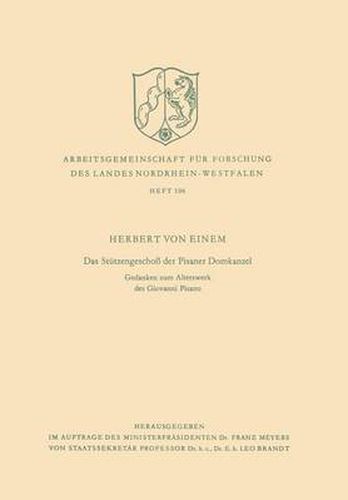Readings Newsletter
Become a Readings Member to make your shopping experience even easier.
Sign in or sign up for free!
You’re not far away from qualifying for FREE standard shipping within Australia
You’ve qualified for FREE standard shipping within Australia
The cart is loading…






This title is printed to order. This book may have been self-published. If so, we cannot guarantee the quality of the content. In the main most books will have gone through the editing process however some may not. We therefore suggest that you be aware of this before ordering this book. If in doubt check either the author or publisher’s details as we are unable to accept any returns unless they are faulty. Please contact us if you have any questions.
The cathedral pulpit in Pisa re fleets a comprehensive construction of ideas in which must be included not only the railing panels and the figures between them, the figures and reliefs of the entresol, but also the figures and groups of figures of the support floor. The 12th verse of the psalm 84 written on the scroll which Christ holds in His left hand provides the key for the interpretation of the support floor: Veritas de terra orta est et I ustitia de Coelo prospexit . Also the 11 th verse of the psalm 84 must be drawn upon: Misericordia et Veritas obviaverunt sibi. Iustitia et Pax osculatae sunt . In theological literature and in painting of the Middle Ages both verses play an important role. Iustitia (Justice) and Veritas (Truth), Pax (Peace) and Misericordia (Mercy) being basic ideas and maxims in Christian thought and action (as can be illustrated by numerous literary and pictorial examples) are understood as virtues as weIl as a direct reference to Christ and His incarnation by Mary. This applies also to the pulpit. The figure of Christ must in this case be understood as Iustitia de Coelo ; the female figure with the children at the breast as Veritas de terra orta . The conception of Iustitia is associated with the conception of Pax just as the idea of Veritas is associated with that of Misericordia.
$9.00 standard shipping within Australia
FREE standard shipping within Australia for orders over $100.00
Express & International shipping calculated at checkout
This title is printed to order. This book may have been self-published. If so, we cannot guarantee the quality of the content. In the main most books will have gone through the editing process however some may not. We therefore suggest that you be aware of this before ordering this book. If in doubt check either the author or publisher’s details as we are unable to accept any returns unless they are faulty. Please contact us if you have any questions.
The cathedral pulpit in Pisa re fleets a comprehensive construction of ideas in which must be included not only the railing panels and the figures between them, the figures and reliefs of the entresol, but also the figures and groups of figures of the support floor. The 12th verse of the psalm 84 written on the scroll which Christ holds in His left hand provides the key for the interpretation of the support floor: Veritas de terra orta est et I ustitia de Coelo prospexit . Also the 11 th verse of the psalm 84 must be drawn upon: Misericordia et Veritas obviaverunt sibi. Iustitia et Pax osculatae sunt . In theological literature and in painting of the Middle Ages both verses play an important role. Iustitia (Justice) and Veritas (Truth), Pax (Peace) and Misericordia (Mercy) being basic ideas and maxims in Christian thought and action (as can be illustrated by numerous literary and pictorial examples) are understood as virtues as weIl as a direct reference to Christ and His incarnation by Mary. This applies also to the pulpit. The figure of Christ must in this case be understood as Iustitia de Coelo ; the female figure with the children at the breast as Veritas de terra orta . The conception of Iustitia is associated with the conception of Pax just as the idea of Veritas is associated with that of Misericordia.